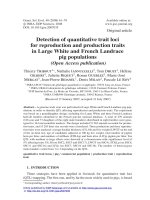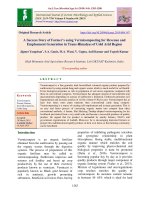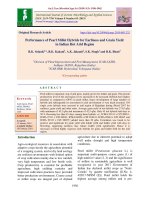Performance of pearl millet hybrids for earliness and grain yield in Indian hot arid region
Bạn đang xem bản rút gọn của tài liệu. Xem và tải ngay bản đầy đủ của tài liệu tại đây (220.61 KB, 7 trang )
Int.J.Curr.Microbiol.App.Sci (2019) 8(3): 1956-1962
International Journal of Current Microbiology and Applied Sciences
ISSN: 2319-7706 Volume 8 Number 03 (2019)
Journal homepage:
Original Research Article
/>
Performance of Pearl Millet Hybrids for Earliness and Grain Yield
in Indian Hot Arid Region
R.K. Solanki1*, R.K. Kakani1, A.K. Jukanti2, S.K. Singh1 and R.K. Bhatt1
1
Division of Plant Improvement and Pest Management, ICAR-CAZRI,
Jodhpur-342003, Rajasthan (India)
2
ICAR-IIRR, Hyderabad, Telangana (India)
*Corresponding author
ABSTRACT
Keywords
Arid region, Pearl
millet, Hybrid,
Earliness, Grain
yield
Article Info
Accepted:
15 January 2019
Available Online:
10 February 2019
Pearl millet is important crop of arid parts, mainly grown for fodder and grain. The present
productivity level of the arid region is low and needs to be increased. Hybrids have higher
potential as compared to OPVs in pearl millet, hence development of large number of
hybrids and subsequently its assessment in arid environment is very much essential. 184
single cross hybrids were assessed in arid region of Rajasthan during Kharif 2017 for
earliness, grain yield and other traits. Average grain yield of test hybrids was 27.63 q/ha
with minimum of 10.2 q/ha and maximum of 42.5 q/ha. Only 45 test hybrids had days to
50 % flowering less than 45 days, among them hybrids viz., ICMA 93333 x CZI 2003/1,
ICMA 97111 x CZI 2003/1, ICMA 04999 x CZI 2010/11, ICMA 05444 x CZI 2003/1 and
ICMA 93333 x CZI 2007/9 yielded more than 30 q/ha. Correlation was found to be
positive and significant for grain yield with fodder yield and fodder yield with days to
flowering, suggesting earliness may reduce fodder yield significantly. Hence it is
necessary to breed highly vigorous early hybrids for grain and fodder both for the arid
region.
Introduction
Agro-ecological resources in association with
adaptive crops decide the agriculture potential
of a cropping system, arid or dry land ecology
are resilient environments with limited option
of crop cultivation mainly due to low rainfall,
very high temperature and low fertile soils.
Crop productivity is essential for profitable
agriculture, high yielding varieties and
improved cultivation practices have provided
better production environments. Coarse cereal
or millet crops are integral part of dryland
agriculture due to inherent potential to adopt
well under drought and high temperature
conditions.
Pearl millet (Pennisetum glaucum L.) is
important multi-purpose coarse grain (1) of
high nutritive value (2, 3) and the significance
of millets in sustainable agriculture is well
recognized, in year 2017 Government of
Indian has declared millet crops as ‘NutriCereals’ by gazette notification [G.No: 44/2017-NFSM (E)]. Pearl millet holds the
highest acreage among millets and is pre-
1956
Int.J.Curr.Microbiol.App.Sci (2019) 8(3): 1956-1962
dominantly grown in the western arid/semi
arid regions for grain and fodder. In India it is
cultivated in around 8.0 million hectare (mha)
area contributing 9.63 million tonnes (mt) of
grain. In western region, Rajasthan state
covers 56 per cent of national acreage of
which 73 per cent area lies in hot arid parts of
the state, contributing 4.01 and 2.32 million
tonnes
of
grains
respectively
(4).
Interestingly, pearl millet productivity has
increased noticeably over time, in 1981 it was
458 kg ha-1 which reached 1147 kg ha-1 in
2017 (4, 5). Improved cultivars in pearl millet
basically OPVs (Open pollinated varieties)
and SCH (Single cross hybrids) are cultivated
in large, but hybrids yield higher than OPVs
with yield advantage ranging from 19 to 35
percent (5). In Rajasthan pearl millet is
cultivated in hot arid parts i.e., in Jodhpur,
Bikaner, Sikar, Jalore and Ganga Nagar
regions; Bikaner and Jodhpur have lowest
productivity accounting 5.77 and 6.30 q ha-1,
but in acreage Jodhpur ranks first with 1.343
mha followed by Sikar (0.979 mha) and
Bikaner (0.598 mha) (4).
Varieties have contributed significantly in
increasing the pearl millet grain production,
therefore to enhance the low productivity of
hot arid regions its necessary to develop early
high yielding hybrids having tolerance to
drought, high temperature and diseases
mainly downy mildew and blast. Genetic
performance of hybrids in arid environment
has been assessed in past, many hybrid
cultivars have been developed which are
getting popularity for commercial cultivation
(4, 6). Breeding is a continuous process and
it’s necessary to develop large number of high
yielding hybrids for harsh arid environment.
Screening
of
hybrids
under
target
environment
can
definitely
provide
opportunities to identify and develop better
cultivars for arid farmers. In the present
investigation 184 single cross hybrids were
evaluated for grain yield and other traits in
arid region of Rajasthan, identified promising
early hybrids with high fertility restoration
can be further evaluated at multi-locations in
arid region.
Materials and Methods
Single cross test hybrids (184) were
developed at ICRISAT, Patancheru during
Summer-2017 using twelve male sterile (ms)
lines of ICRISAT, Patancheru viz., ICMA
(ICRISAT Millet A) lines of designated
number 00777, 04999, 08111, 09111, 09666,
841, 88004, 92777, 93333, 97111, 05777 and
CAZRI ms line CZMA 21 were randomly
crossed with 27 inbred restorers developed by
CAZRI viz., CZI (CAZRI Inbred) lines of
designated number 99/8, 2000/13, 2000/7,
2002/15, 2002/19, 2003/1, 2003/8, 2005/22,
2007/11, 2007/7, 2007/9, 2008/4, 2008/8,
2010/11, 2010/14, 2010/5, 2011/2, 2011/7,
2012/10, 2012/8, 2013/11, 2013/8, 2014/1,
2014/3, 2014/5, 2014/6, 2014/7. These
hybrids were evaluated for grain yield and
other agro-morphological traits at ICARCAZRI, Jodhpur research farm (26°18’N and
73°01’E) in four trials located in the same
field laid continuously i.e., Hybrid Trial I
(HT-I), HT-II, HT-III and HT-IV, each HT
comprised of 46 test hybrids and four check
varieties. Hybrid trials were conducted in
RBD with three replication, each entry was
planted in 2 rows of 4 m length with 60 cm
row spacing and 12-15 cm plant to plant
distance was maintained by thinning at 12-15
days stage of crop growth. Trials were sown
immediately after rainfall in month of June
2017; at the time of sowing fertilizer N @ of
20 kg/ha and P2O5 @ 20 kg/ha was applied,
followed by 20 kg N/ha as top dressing and
maintained as rainfed throughout the season.
During the season, 361 mm rainfall was
received with 10 well distributed events of
more than 10 mm rainfall; overall the crop
performance was good as no water stress was
observed. Observation were recorded for days
1957
Int.J.Curr.Microbiol.App.Sci (2019) 8(3): 1956-1962
to 50 % flowering (DF50), plant height (cm)
(PH), number of effective tillers (ET), ear
head length (cm) (EHL), ear head girth (cm)
(EHG), test weight (g) (TW), fodder yield
(q/ha) (FY), grain yield (q/ha) (GY). All the
trials were analysed separately using Indostat
software; Independent comparison of hybrids
was done on mean values in each HT and
later pooled analysis of mean was also done
to have an overall view. Grain yield
correlation with other agro-morphological
traits was also worked out to get a view of
association
involved
in
phenotypic
expression.
Results and Discussion
Analysis of variance indicated significant
differences among 184 test cross hybrids in
the four hybrid trials (Table 1). The mean
performance of test hybrids showed huge
variation for the traits studied (Table 2),
among 184 hybrids 77 showed high fertility
restoration, 28 had partial fertility restoration
and 79 combinations failed restore fertility.
The average grain yield of 184 test hybrids
was calculated irrespective of fertility
restoration to see the potential of hybrid in
arid regions, the overall mean was 27 q ha-1
with minimum of 10.2 q ha-1 and maximum of
q ha-1 (Table 3), which is higher than the
Rajasthan state mean (8.70 q ha-1) and
Jodhpur Region mean (6.30 q ha-1) (4).
Higher grain yield of test hybrids is coupled
effect of hybrid vigour and good rainfall,
hence it clearly suggests that hybrids have
good potential under favorable environment
in arid regions.
Variation based on overall mean showed that
days to 50% flowering had minimum
variation (5.49 %) as expected in test hybrids
due to product of early restorer inbreds;
variation was also low for plant height (8.6
%), ear head girth (9.4 %). High variation was
observed for tillers per plant (24.91 %),
fodder yield (24.26 %; maximum yield of
112.5 q ha-1 and minimum of 26.7 q ha-1,
followed by grain yield (20.68 %). Further
hybrids were analyzed independently in each
trial as per experimental design to minimize
the effect of field heterogeneity over larger
area on hybrid performance.
In arid regions early high yielding hybrids are
very much essential to be developed, hence,
based on earliness (DF50 % < 45 days), grain
yield (> 20 q ha-1) and high fertility
restoration percentage 14 promising test
hybrids were identified (Table 2); of which
ICMA 93333 x CZI 2003/1, ICMA 97111 x
CZI 2003/1, ICMA 04999 x CZI 2010/11,
ICMA 05444 x CZI 2003/1 and ICMA 93333
x CZI 2007/9 yielded more than 30 q ha -1.
These hybrids also showed resistant reaction
against downy mildew in sick conditions.
Correlation of grain yield was maximum and
positive with fodder yield (0.60) followed by
plant height (0.20), ear head length (0.15) and
ear head girth (0.15). Fodder yield was
significantly correlated in positive direction
with plant height (0.46) and days to flowering
(0.41) (Table 4). The objective of breeding
dual purpose hybrids for fodder and grain is
addressed in the set of hybrids developed. On
the other hand incorporating earliness in
hybrids will cause yield loss for fodder which
will subsequently reduce the grain yield,
hence for breeding early hybrids it’s
necessary to have very high vigour in hybrids
for biological growth and high grain yield.
High grain yield and earliness in hybrids is
the prime requirement for developing
cultivars suitable for hot arid regions as they
can escape terminal drought due to problem
of scantly and erratic rainfall patterns. Dual
purpose objective of getting more fodder and
grain is important as fodder requirement is
met significantly by pearl millet harvest in
arid parts.
1958
Int.J.Curr.Microbiol.App.Sci (2019) 8(3): 1956-1962
Table.1 ANOVA for days to 50% flowering, fodder yield (q/ha), grain yield (q/ha), test weight (g)
HT-1
HT-2
HT-3
HT-4
HT-1
HT-2
HT-3
HT-4
Test weight (g)
HT-4
HT-3
HT-2
HT-1
Grain Yield (q/ha)
HT-4
Fodder yield (q/ha)
HT-3
Replication 2
Days to 50 % Flowering
HT-2
df
HT-1
Source
4.01
2.10
0.62
5.62
160.48
88.25
210.50
91.65
26.28
32.26
14.58
47.87
0.31
0.51
0.99
0.60
Treatment
49
13.16*
23.71*
24.12*
17.71*
336.59*
937.84*
647.10^
700.71*
93.38*
120.72*
87.27*
64.98*
2.31*
3.41*
2.97*
4.36*
Error
98
2.449
1.62
1.34
1.96
119.50
157.02
135.75
113.83
32.03
31.11
30.47
30.28
0.26
0.38
0.35
0.22
Mean
-
48.29
47.82
46.64
47.37
59.22
59.76
61.50
62.24
26.45
25.65
29.00
29.38
7.89
8.34
7.91
8.78
CD (0.05)
-
2.53
2.06
1.87
2.26
17.71
20.30
18.87
17.28
9.17
9.03
8.94
8.91
0.83
1.01
0.96
0.77
CV (%)
-
3.24
2.66
2.48
2.96
18.46
20.97
18.95
17.14
21.39
21.74
19.03
18.73
6.55
7.47
7.54
5.42
1959
Int.J.Curr.Microbiol.App.Sci (2019) 8(3): 1956-1962
Table.2 Superior test hybrids having high fertility restoration, earliness and high grain yield
Trial
Single cross test hybrids
HT-1
ICMA 04999 x CZI 2010/11
ICMA 93333 x 2007/9
CZMS 21A x CZI 2014/3
ICMA 05444 x CZI 2010/11
ICMA 93333 x CZI 2003/1
ICMA 97111 x CZI 2003/1
ICMA 97111 x CZI 2014/5
ICMA 841 x CZI 2000/7
ICMA 97111 x CZI 2010/11
ICMA 05444 x CZI 2003/1
ICMA 00777 x CZI 2007/9
ICMA 00777 x CZI 2003/8
ICMA 08111 x CZI 2003/1
ICMA 09111 x CZI 99/8
HT-2
HT-3
HT-4
Days to
50 %
Flowering
Plant
Height
(cm)
45
44
45
45
44
45
45
45
45
45
43
45
45
44
217.3
206.9
212.8
216.7
211.1
215.8
237.4
222.7
216.9
216.2
203.6
231.1
231.6
198.5
Ear
head
length
(cm)
19.8
20.3
23.6
19.7
18.6
21.4
22.4
25.4
18.6
20.2
19.9
20.8
22.8
24.1
HT: Hybrid Trial
1960
Ear
head
girth
(cm)
2.5
2.8
2.3
2.4
2.3
2.6
2.4
2.1
2.6
2.3
2.7
2.5
2.7
2.7
No of
effective
tillers
Test
weight
(g)
Fodder
yield
(q ha -1)
Grain
yield
(q ha -1)
Rank as
per grain
yield
3.0
2.7
2.0
2.9
2.1
1.8
2.4
3.2
1.8
2.2
1.9
2.2
1.7
2.2
7.7
7.4
6.8
8.5
7.3
9.0
8.6
9
8.8
8.6
8.7
6.9
10.2
7.6
72.6
65.6
46.2
70.8
86.1
61.1
54.5
47.2
46.2
74.0
39.6
43.1
57.6
36.5
32.8
31.6
28.6
27.0
35.0
33.2
27.1
26.7
22.1
32.6
23.4
20.7
30.7
20.8
3
5
7
9
1
2
8
10
12
4
11
14
6
13
Int.J.Curr.Microbiol.App.Sci (2019) 8(3): 1956-1962
Table.3 Variability observed in the test hybrid in arid conditions
Characters
Mean
Min
Max
Days to 50% flowering
Plant height (cm)
Ear Length (cm)
Ear Girth (cm)
Effective tillers (nos.)
Test weight (g)
Fodder yield (q ha -1)
Grain Yield (q ha -1)
47.53
220.96
21.68
2.57
2.27
8.23
60.69
27.63
41.30
130.10
17.50
1.90
1.10
5.90
26.70
10.20
54.3
265.3
45.00
3.10
4.10
11.30
112.5
42.5
Variation (%)
based on
overall mean
5.49
8.60
11.86
9.40
24.91
13.35
24.26
20.68
Table.4 Correlations between different yield and yield attributes
Characters
Days to 50% flowering
Plant height (cm)
Ear length (cm)
Ear girth (cm)
Effective tillers (nos.)
Test weight (g)
Fodder yield (q ha -1)
Grain yield (q ha -1)
Day to
50%
floweri
ng
1.00
Plant
height
(cm)
Ear
head
length
(cm)
0.36** 0.19**
1.00 0.33**
1.00
In the set of hybrids evaluated, hybrid ICMA
93333 x CZI 2003/1, ICMA 97111 x CZI
2003/1, ICMA 04999 x CZI 2010/11, ICMA
05444 x CZI 2003/1 and ICMA 93333 x CZI
2007/9 has high potential they are early and
high yielder. The said hybrids need to be
evaluated at multi-location in arid regions for
identification of potential hybrids for
commercial cultivation in the western arid
parts of India.
Ear
head
girth
(cm)
0.42**
0.15*
0.10
1.00
Effective Test
Fodder
tillers
weight
yield
(nos.)
(g)
(q ha -1)
-0.06
-0.06
-0.09
-0.24**
1.00
-0.16*
-0.11
-0.06
0.22**
-0.15*
1.00
0.41**
0.46**
0.03
0.25**
-0.03
-0.06
1.00
Grain
yield
(q ha 1
)
-0.08
0.20**
0.15*
0.15*
0.07
-0.05
0.60**
1.00
for development of test hybrids and Director
CAZRI for providing needful facility and
support.
References
Acknowledgement
Authors gratefully acknowledge ICRISAT,
Patancheru, for sharing of male sterile lines
1961
1. Jalaja, N., Maheshwari, P., Naidu, K.R.,
and Kavi Kishor, P.B. 2016. In vitro
regeneration and optimization of
conditions for transformation methods in
Pearl millet, Pennisetum glaucum (L.).
International Journal of Clinical &
Biological Sciences. 1: 34–52.
2. Singh, N., Singh, S.P., Kumar, M.,
Kanhiya, K. and Kumar, A. 2018. Nutri
Int.J.Curr.Microbiol.App.Sci (2019) 8(3): 1956-1962
Cereal Pearlmillet: Way Forward.
International
Journal
of
Current
Microbiology and Applied Sciences. 7
(6): 578-581.
3. Are, A. K., Srivastava, R. K.,
Mahalingam,
G.,
Gorthy,
S.,
Gaddameddi, A., Kunapareddy, A.,
Kotla, A. and Jaganathan, J. 2018.
Application of plant breeding and
genomics for improved sorghum and
pearl millet grain nutritional quality: In
Sorghum and Millets, IInd Ed. Elsevier
International. Pp 51-68.
4. Solanki, R. K., Mahla, H. R., Kakani, R.
K., Choudhary, K. B. and Sharma, R.
2018. Stress tolerant crop varieties of
major arid zone crops to promote
resilience to climatic stresses. Indian
Farming. 68 (9): 41-45.
5. Yadav, O. P., Singh, D. V., Vadez, V.,
Gupta, S. K., Rajpurohit, B. S. and
Shekhawat, P. S. 2017. Improving pearl
millet for drought tolerance – Retrospect
and prospects. Indian Journal of Genetics
and Plant Breeding. 77(4): 464-474.
6. Manga, V. K., Aravind, J. K. and Bhatt,
R. K. 2015. Adaptation and selection of
crop varieties for hot arid climate of
Rajasthan. Indian Journal of Plant
Sciences. 4(4): 1-9.
How to cite this article:
Solanki, R.K., R.K. Kakani, A.K. Jukanti, S.K. Singh and Bhatt, R.K. 2019. Performance of
Pearl Millet Hybrids for Earliness and Grain Yield in Indian Hot Arid Region.
Int.J.Curr.Microbiol.App.Sci. 8(03): 1956-1962. doi: />
1962






![Genetic analysis for micronutrients and grain yield in relation to diverse sources of cytoplasm in pearl millet [Pennisetum glaucum (L.) R. Br.]](https://media.store123doc.com/images/document/2020_01/13/medium_ion1578932058.jpg)


